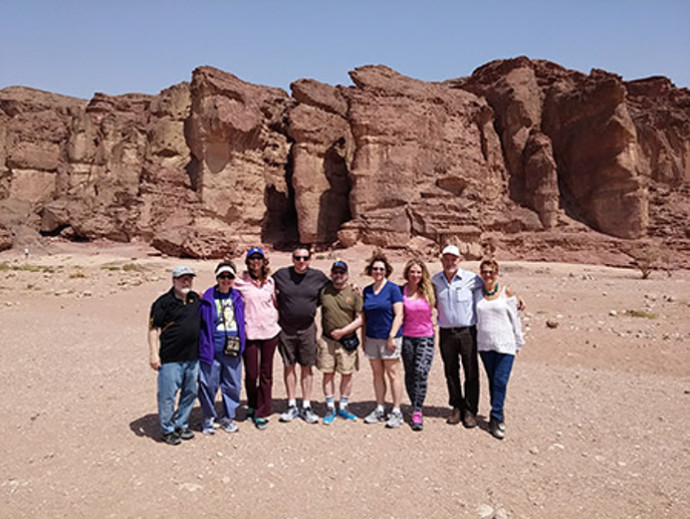Underneath a deep, endless azure and violet sky and surrounded by vibrant hues of golden orange and blood red – the sun begins to set just above the horizon. The landscape is marked by monumental geological architecture – natural rock formations and ancient quarries whose faces nakedly bear the scars and stains of tens of millions of years’ worth of environmental and human cultural evolution.
This is Timna National Park in Southern Israel’s Arava desert, one of the largest parks in Israel, and a crown jewel among the country’s many natural landscapes. Its many hidden valleys, pathways, and trails are open to visitors of all ages but until the 1980s it was neglected and undeveloped. Today, thanks to the work of Avrum Chudnow (z”l) and his family, and powered by Jewish National Fund-USA, the new Chudnow Family Visitor Center welcomes adventurers of all types and ages to a site brimming with options and bustling with activity.
With the generous donation and creative direction from Avrum Chudnow and his brother Joseph Chudnow, whose work and legacies have been carried on by their children, grandchildren and relatives, a plan was developed in the mid ‘80s for how to best reveal Timna and all it has to offer. Jewish National Fund-USA helped in many ways, including creating a breathtaking man-made lake which guests can paddleboat on or watch the fading sunset shimmer on the mirror-like water. The roads and surrounding economy also garnered support from the Israeli tourism ministry, the parks authority, and various other organizations.

Today, Timna is a private park run by the Hevel Eilot regional council. There are two dozen walking trails, roads, tourist, and family attractions, and a “4D” light and sound show. Beaming with pride, Avrum’s son, David Chudnow, explained how he’s been involved with Timna for nearly 40 years. “We’ve had at least 15 phases of development since I first joined the project. The visitor’s center and accompanying restaurant is the latest one and it’s a tremendous addition to the quality of experience that people have there. From hiking trails to archaeological discoveries, there’s something for everyone and now there’s also a place to cool down, rest, eat, and make a full day of it.”
Timna Park Ranger, Ron Bernstein, explains that there are two types of guided tours on offer: sunset and lantern tours. These hikes wind through the desert on trails that are unknown to anyone but the rangers. Then while enroute, Rangers like Bernstein walk visitors through what they see in detail; what the Arava desert is – its dangers, beauty, and magnificent flora and fauna. The guides also discuss the rare, natural geological formations including massive red sandstone rocks shaped by time into mushrooms (aka Hoodoos), arches, and the so-called ‘Solomon Pillars’ – all of which tower 100-plus feet overhead.

This is all to say nothing of the site’s significance to human and Jewish history and culture. Even today, there are ongoing archaeological digs at the site. The area was surrounded by some 10,000 ancient copper mines where people began to refine the metal around 6,000 years ago – starting with the Egyptians and continuing with the Edomites and the Israelites. In fact, the most recent discovery of the oldest purple dye in the world, that and the other recent textile and other finds provide important links to King Solomon’s empire and the validity of the Biblical text, in fact, some historians and archaeologists believe that Timna could be the site of King Solomon’s fabled mines. As David Chudnow explained, “Timna is now poised to graduate from being a great place for hiking and recreation to becoming a significant historical site in the region and to the world.”
Then after the pillars and shrines – there’s still far more to see. Bernstein elaborated: “We go to the lake; there are caravans, tents for glamping, a restaurant, etc. One of the highlights (also during the day) is that the visitors receive a little bottle filled with a design made up of the different colored sands found naturally in the park – sand turned green with copper, black by manganese, yellow from sulfate, and red by iron.”
For David Chudnow, the continuation of his father’s legacy intertwined with the exploration of Jewish heritage in the park and the vitality it brings to the southern region is a perfect blend. “My father said that Timna was his greatest achievement, it will be there for generations to come,” he said. “There’s food, hiking, bicycling, major events from operas to yoga festivals, it’s a beautiful place where everyone can find something to connect to and we’re continuing to develop its full potential.”
Thinking of visiting Timna Park and other iconic sites in Israel? Plan your next visit at jnf.org/travel.
